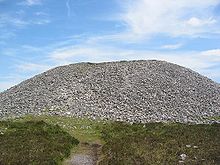Knocknarea
| Bone area / Cnoc na Riabh | ||
|---|---|---|
| height | 327 m | |
| location | County Sligo , Ireland | |
| Coordinates | 54 ° 15 '32 " N , 8 ° 34' 23" W | |
|
|
||
The Knocknarea ( Irish Cnoc na Riabh ) is a 327 m high, monolithic limestone mountain on the Coolera Peninsula ( Cúil Iorra ) in the Irish county of Sligo and next to the Ben Bulben the second prominent elevation near the city of Sligo . The mountain is noticeable from a distance due to its evenly rounded shape and the stone mound that was built on its summit about 5000 years ago.
Surname
The translation of the name is disputed.
Cnoc means "hill", riabh means "strip", hence "strip hill ". However -rea is also interpreted as ré ("moon") or rí ("king"), so Knocknarea could also mean "moon mountain" or "king hill".
The large number of visitors has caused serious erosion of the hill. Visitors climb the hill, destroying the sward that kept stones from sliding down, and took stones from the mound to lay their names in the heather. The well-intentioned call to bring stones to Maeve's grave rather than remove them has led to the growth of a small new mound on the top of the grave, which falsifies the shape of the originally presumably flat hilltop.
Archaeological finds
Cairns are located on the ridge of the Knocknarea . The largest is called Queen Maeve's Grave ( Meascán Mhéabha ). Since this was built around 3000 years before Christ, it cannot be the tomb of the legendary Celtic Queen Maeve of Connacht . Allegedly she is buried here in an upright position and in full armor, facing north, facing her enemies in Ulster . The real grave has not yet been excavated. But it is unlikely that the mythical Queen of the Iron Age is buried there because the tomb is dated to the Neolithic . With a diameter of 55 meters and a height of 10 meters, the mound is one of the largest burial mounds in Ireland. The weight of the stones used is estimated at 40,000 tons. Nearby are the Knocknarea South Cairn, the Knocknarea South Alignment (a row of stones ) and the Knocknarea South Stone Circle (a stone circle )
On the flank of the mountain lie the remains of round huts, which are also dated to the Neolithic, as well as trenches on the slope of the mountain.
In 2014, an archaeologist found 13 small bones and fragments of a Stone Age adult and a child in a difficult-to-access cave at Knocknarea . They are considered evidence of the prehistoric practice of excarnation , in which the deceased was laid down in a cave, and after decomposition of the organic matter, the bones were deposited elsewhere. Radiocarbon dating has shown that the skeletal remains of the adult are around 5,500 years old and those of the child are around 5,200 years old, making them the oldest human bones in County Sligo. Sligo and Leitrim Counties are Ireland's main cave regions, but few have been archaeologically explored. The limestone hill has 14 caves on the north side. The gorge on the south side of the hill and the rich marine fauna have been a magnet for people since the Mesolithic.
Surroundings
To the south of the mountain are Carrowmore and Carrowkeel, other important megalithic sites from the Neolithic Age .
literature
- Stefan Bergh: Transforming Knocknarea - The Archeology of a Mountain. In: Archeology in Ireland 52, 2000, pp. 14-18.
- Stefan Bergh: Knocknarea - the ultimate monument. Megaliths and mountains in Neolithic Cúil Irra, North-West Ireland. In: Chris Scarre (Ed.): Monuments and Landscape in Atlantic Europe. Routledge, London, 2002.
- Marion Dowd: The Archeology of Caves in Ireland. Oxbow Books, Oxford, 2015, ISBN 9781782978138
- Peter Harbison : Pre-christian Ireland - From the first Settlers to the early Celts . London 1988, ISBN 0-500-27809-1 , p. 217.
Web links
- Stefan Bergh: Knocknarea: the archeology of a mountain. National University of Ireland, Galway (English, recent research from the University of Galway at Knocknarea).
Individual evidence
- ↑ ?? (No longer available online.) Formerly in the original ; accessed on August 6, 2019 . ( Page no longer available , search in web archives )
- ↑ See for example the picture by Bob Embleton: Names in Stone, Knocknarea. (jpg, 126 kB) In: Wikimedia Commons. August 26, 2006, accessed August 10, 2019 .
- ↑ Martin Byrne: Queen Maeve's Cairn. In: carrowkeel.com. 2017, accessed on August 6, 2019 .
- ↑ Helena Knutsson: Report on microwear analysis of selected items from Knocknarea mountain, Rathcarrick td. Co. Sligo, Ireland. (pdf, 3.1 MB) In: StoneSlab. August 6, 2008, accessed August 6, 2019 .
- ^ Stefan Bergh: Black is the Color. Chert, concave scrapers and passage tombs. In: Gabriel Cooney, O'Connor, B., John Chapman (Eds.): Materialitas: working stone, carving identity (= Prehistoric Society Research Papers 3). The Prehistoric Society / Oxbow Books, Oxford, 2010.



